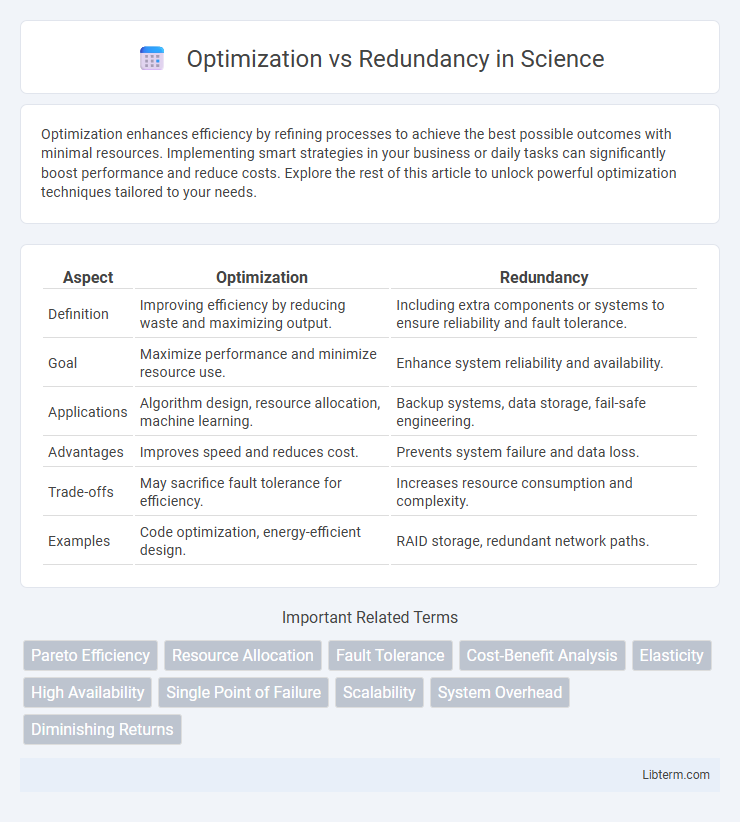Optimization enhances efficiency by refining processes to achieve the best possible outcomes with minimal resources. Implementing smart strategies in your business or daily tasks can significantly boost performance and reduce costs. Explore the rest of this article to unlock powerful optimization techniques tailored to your needs.
Table of Comparison
| Aspect | Optimization | Redundancy |
|---|---|---|
| Definition | Improving efficiency by reducing waste and maximizing output. | Including extra components or systems to ensure reliability and fault tolerance. |
| Goal | Maximize performance and minimize resource use. | Enhance system reliability and availability. |
| Applications | Algorithm design, resource allocation, machine learning. | Backup systems, data storage, fail-safe engineering. |
| Advantages | Improves speed and reduces cost. | Prevents system failure and data loss. |
| Trade-offs | May sacrifice fault tolerance for efficiency. | Increases resource consumption and complexity. |
| Examples | Code optimization, energy-efficient design. | RAID storage, redundant network paths. |
Understanding Optimization and Redundancy
Optimization involves enhancing system performance by efficiently allocating resources to maximize output or reduce costs, often through algorithmic improvements and process streamlining. Redundancy refers to the inclusion of extra components or pathways to ensure reliability and fault tolerance, preventing failure when primary elements malfunction. Balancing optimization and redundancy is critical in engineering and IT to achieve robust yet efficient system designs.
Core Differences Between Optimization and Redundancy
Optimization enhances system performance by minimizing resources and eliminating inefficiencies to achieve maximum output with minimum input. Redundancy involves incorporating additional resources or components to ensure reliability and fault tolerance, often at the expense of increased complexity and cost. The core difference lies in optimization prioritizing efficiency and lean design, whereas redundancy emphasizes reliability and system robustness through duplication.
Benefits of Process Optimization
Process optimization enhances operational efficiency by reducing waste, lowering costs, and accelerating workflow, leading to higher productivity. It improves resource utilization, ensuring that labor, materials, and technology are employed more effectively to achieve business goals. Optimized processes support scalability and adaptability, enabling organizations to respond quickly to market changes without unnecessary redundancy.
Advantages of Building Redundancy
Building redundancy enhances system reliability by providing backup components or pathways that ensure continuous operation during failures. It increases fault tolerance, minimizing downtime and maintaining service availability in critical applications such as data centers and telecommunications. Redundancy also supports scalability and adaptability, allowing systems to handle unexpected loads or component failures without performance degradation.
Risks of Over-Optimization
Over-optimization in systems can lead to reduced resilience and increased vulnerability to unexpected failures by eliminating redundancy that serves as a safety net. Excessive focus on maximizing efficiency may compromise flexibility, making it harder to adapt to changing conditions or recover from disruptions. Balancing optimization with strategic redundancy ensures robust performance while mitigating risks associated with single points of failure.
Downsides of Excessive Redundancy
Excessive redundancy can lead to resource inefficiency by increasing storage and maintenance costs without proportional benefits in error tolerance. It often causes system complexity that hinders performance optimization and slows down data processing speeds. Over-redundant architectures may also introduce synchronization issues, resulting in inconsistent or outdated information across duplicated components.
Achieving Balance: When to Optimize vs. When to Add Redundancy
Achieving balance between optimization and redundancy involves assessing system criticality and performance needs; optimization enhances efficiency by minimizing resource use, while redundancy ensures reliability through backup components. In high-stakes environments like data centers or healthcare systems, adding redundancy outweighs optimization to prevent failures and data loss. Conversely, in cost-sensitive or performance-driven applications, prioritizing optimization reduces overhead, but careful redundancy planning safeguards against unexpected downtime.
Industry Applications: Optimization vs. Redundancy in Practice
Industry applications often balance optimization and redundancy to enhance system efficiency and reliability; optimization aims to minimize resource use and costs, while redundancy ensures fault tolerance and continuous operation. In manufacturing, optimized processes reduce production time and waste, whereas redundant machinery prevents downtime during equipment failure. Data centers implement optimized server allocation for energy savings, contrasted by redundant power supplies and network paths to maintain uptime under disruptions.
Case Studies: Successful Strategies in Balancing
Case studies in technology infrastructure reveal that balancing optimization and redundancy is crucial for maintaining high system availability and cost-efficiency. Companies like Netflix implement adaptive redundancy, using multiple cloud providers and real-time traffic rerouting to optimize resource use while ensuring fault tolerance. Similarly, Amazon Web Services employs auto-scaling combined with redundant backups to achieve a resilient yet cost-effective platform.
Future Trends in Optimization and Redundancy
Future trends in optimization emphasize leveraging artificial intelligence and machine learning to enhance system efficiency and resource allocation dynamically. Redundancy strategies are evolving towards intelligent, predictive models that minimize waste while ensuring fault tolerance and high availability. Integration of edge computing and decentralized architectures will further balance optimization and redundancy for resilient and adaptive networks.
Optimization Infographic

 libterm.com
libterm.com